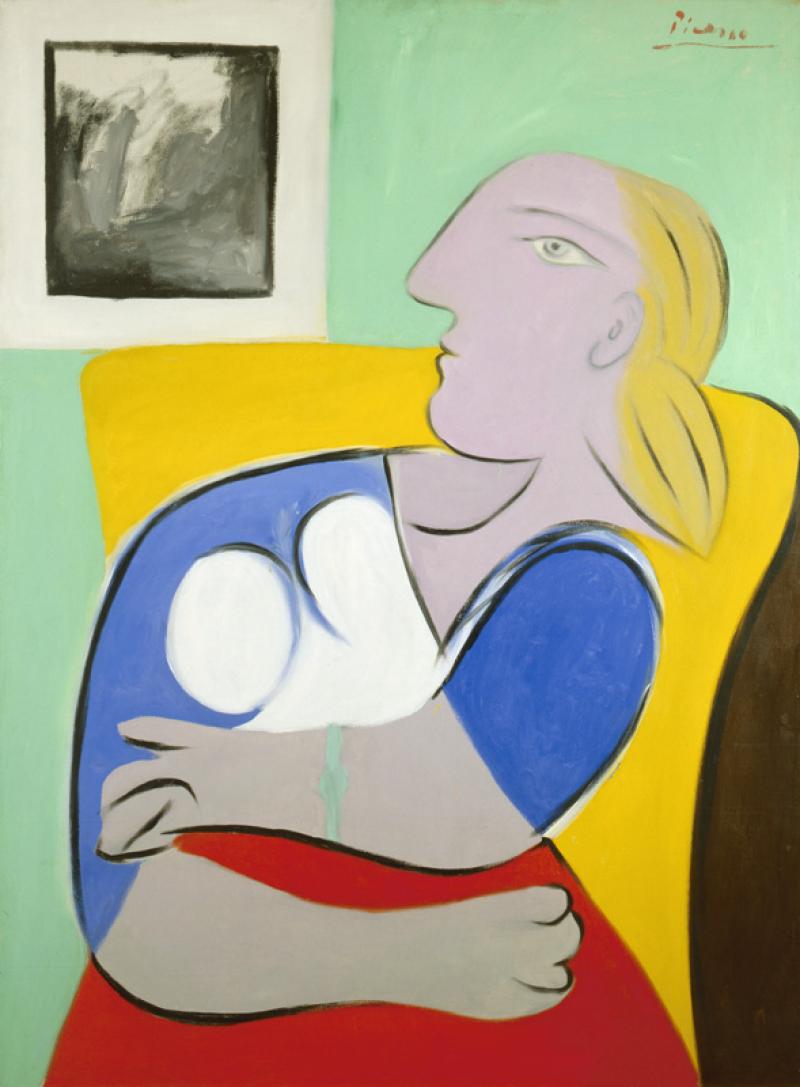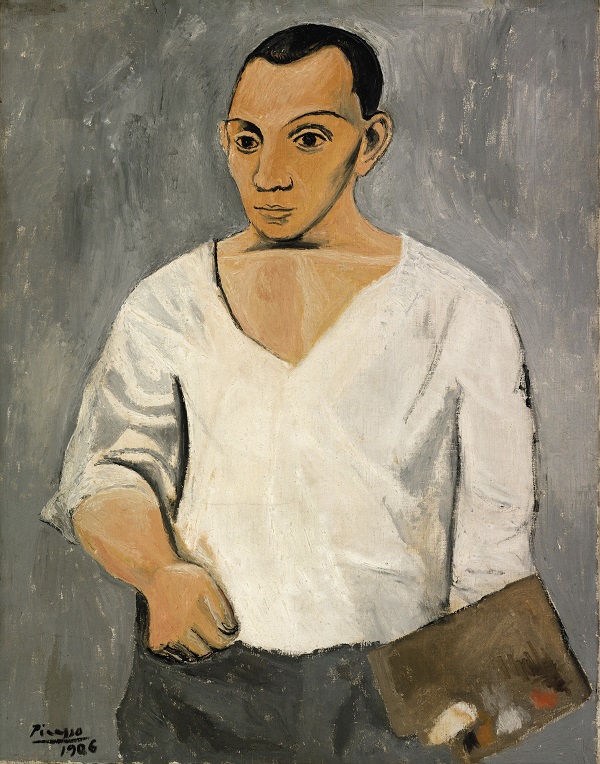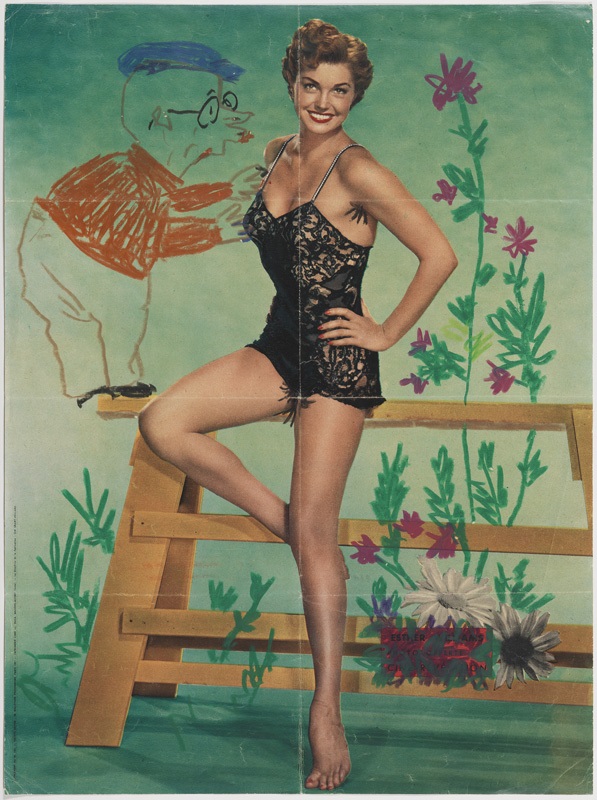Picasso Portraits, National Portrait Gallery | reviews, news & interviews
Picasso Portraits, National Portrait Gallery
Picasso Portraits, National Portrait Gallery
Experimental and incisive, portraits that reveal a man as vicious as he was affectionate

There’s something familiar about those dark, piercing eyes, but the impenetrable, mask-like countenance of Picasso’s Self-Portrait with Palette, 1906, is ultimately unknowable. In fact, the painting serves as something of a rebuke: we think we know Picasso so well, but we don’t.
There are tiny, pen and ink portraits of his cronies at Els Quatre Gats, the legendary watering hole of Barcelona’s artists and writers, and larger, meditative self-portraits that flit between styles and moods: a dark, introspective piece in the manner of Velasquez is paired with his self-portrait in an 18th-century wig, the loose brushstrokes in keeping with the louche persona he has adopted.
 Picasso wasn’t doing anything particularly outlandish of course, the study of the Old Masters was standard practice for students learning their craft, and it is usual for artists to go through phases, imitating others as they find a voice of their own. Picasso did all of these things. And yet you get the sense that for him this was less a process of developing artistic maturity and more an early declaration of a multi-faceted artistic persona.
Picasso wasn’t doing anything particularly outlandish of course, the study of the Old Masters was standard practice for students learning their craft, and it is usual for artists to go through phases, imitating others as they find a voice of their own. Picasso did all of these things. And yet you get the sense that for him this was less a process of developing artistic maturity and more an early declaration of a multi-faceted artistic persona.
A frank homage to Cézanne’s own portrait with a palette, Picasso’s painting (pictured right) serves as a sort of manifesto, setting out the interests and preoccupations that would recur throughout his career. His dialogues with his artist ancestors, from pioneers of modernism like Cézanne to the Old Masters, deepened with age, culminating in the complex interrogations of works by Velasquez and Rembrandt that form the culmination of this exhibition.
For some artists, portraiture forms a discrete strand of endeavour not always easy to reconcile with the rest of their work, but for Picasso, portraits of friends and family provided an opportunity to experiment with ideas that relate directly to his wider practice. The mask-like face of his self-portrait, inspired by his interest in African art, would become a familiar motif, with African masks appearing most famously in Les Demoiselles d’Avignon, 1907, where they introduce a note of menace and savagery, while in the Portrait of Gertrude Stein, 1906, the same device stands for classicising solidity and permanence.
Here though, the mask subverts the usual power relationships of portraiture, and combined with a physical presence more suited to a boxer than a painter, it returns our gaze with force. Pared down to simple, clean lines, the painting alludes to the classicising tendencies that would recur in Picasso’s work, while simultaneously casting him as a worker, an artisan, a man of purpose.
 In light of this self-portrait, Picasso’s use of different styles seems to parallel his fondness for experimenting with different personas, fitting style and technique to each subject much as he might select costumes and props. Nusch Éluard, 1937, is a feast of vivid colour, the simplified, abstract treatment of the face exaggerating her eyes, mouth and teeth, to create an overwhelming impression of laughter and gaiety. In contrast, his studies of Marie-Thérèse Walter have the quality of Old Master drawings, emphasising his imagining of her as a Renaissance Madonna.
In light of this self-portrait, Picasso’s use of different styles seems to parallel his fondness for experimenting with different personas, fitting style and technique to each subject much as he might select costumes and props. Nusch Éluard, 1937, is a feast of vivid colour, the simplified, abstract treatment of the face exaggerating her eyes, mouth and teeth, to create an overwhelming impression of laughter and gaiety. In contrast, his studies of Marie-Thérèse Walter have the quality of Old Master drawings, emphasising his imagining of her as a Renaissance Madonna.
Picasso’s portraits often include elements of caricature, allowing him to enhance aspects of his subjects’ personalities and appearance. But he was just as inclined to employ caricature in undiluted form to poke fun at people, and his friend Jaume Sabartés, later his biographer and secretary, was a frequent target for brutal ridicule (pictured above left: Humorous Composition: Jaumes Sabartes and Esther Williams, 1957). While it is said that he reserved this sort of treatment for his nearest and dearest, Picasso’s mockery of his adoring friend betrays a hefty measure of contempt mixed in with affection.
If Picasso’s treatment of Sabartés sometimes looks a lot like bullying, the room devoted to Picasso’s first wife Olga catalogues the death of a love affair in heartbreaking and sometimes sadistic detail. From the elegant, Ingres-inspired beauty of 1918, Olga becomes gradually more distant, her slight ballerina’s body cruelly transformed into a great mountain of flesh in a drawing of her and their infant son from 1921.
Picasso’s skills as a caricaturist come to the fore in his famous Woman in a Hat (Olga), of 1935, the abstract style allowing the mocking emphasis of Olga’s taste in hats, the downward slant of the mouth and sickly complexion an unforgiving treatment of a woman in the pit of despair. The extent of their estrangement is bitterly expressed by the comparison with the portrait of Dora Maar (main picture), whose voluptuous and inviting body is rendered in sweeping curves and joyful colours.
- Picasso Portraits at the National Portrait Gallery until 5 February 2017
rating
Share this article
The future of Arts Journalism
You can stop theartsdesk.com closing!
We urgently need financing to survive. Our fundraising drive has thus far raised £49,000 but we need to reach £100,000 or we will be forced to close. Please contribute here: https://gofund.me/c3f6033d
And if you can forward this information to anyone who might assist, we’d be grateful.

Subscribe to theartsdesk.com
Thank you for continuing to read our work on theartsdesk.com. For unlimited access to every article in its entirety, including our archive of more than 15,000 pieces, we're asking for £5 per month or £40 per year. We feel it's a very good deal, and hope you do too.
To take a subscription now simply click here.
And if you're looking for that extra gift for a friend or family member, why not treat them to a theartsdesk.com gift subscription?
more Visual arts
 'We are bowled over!' Thank you for your messages of love and support
Much-appreciated words of commendation from readers and the cultural community
'We are bowled over!' Thank you for your messages of love and support
Much-appreciated words of commendation from readers and the cultural community
![SEX MONEY RACE RELIGION [2016] by Gilbert and George. Installation shot of Gilbert & George 21ST CENTURY PICTURES Hayward Gallery](https://theartsdesk.com/sites/default/files/styles/thumbnail/public/mastimages/Gilbert%20%26%20George_%2021ST%20CENTURY%20PICTURES.%20SEX%20MONEY%20RACE%20RELIGION%20%5B2016%5D.%20Photo_%20Mark%20Blower.%20Courtesy%20of%20the%20Gilbert%20%26%20George%20and%20the%20Hayward%20Gallery._0.jpg?itok=7tVsLyR-) Gilbert & George, 21st Century Pictures, Hayward Gallery review - brash, bright and not so beautiful
The couple's coloured photomontages shout louder than ever, causing sensory overload
Gilbert & George, 21st Century Pictures, Hayward Gallery review - brash, bright and not so beautiful
The couple's coloured photomontages shout louder than ever, causing sensory overload
 Lee Miller, Tate Britain review - an extraordinary career that remains an enigma
Fashion photographer, artist or war reporter; will the real Lee Miller please step forward?
Lee Miller, Tate Britain review - an extraordinary career that remains an enigma
Fashion photographer, artist or war reporter; will the real Lee Miller please step forward?
 Kerry James Marshall: The Histories, Royal Academy review - a triumphant celebration of blackness
Room after room of glorious paintings
Kerry James Marshall: The Histories, Royal Academy review - a triumphant celebration of blackness
Room after room of glorious paintings
 Folkestone Triennial 2025 - landscape, seascape, art lovers' escape
Locally rooted festival brings home many but not all global concerns
Folkestone Triennial 2025 - landscape, seascape, art lovers' escape
Locally rooted festival brings home many but not all global concerns
 Sir Brian Clarke (1953-2025) - a personal tribute
Remembering an artist with a gift for the transcendent
Sir Brian Clarke (1953-2025) - a personal tribute
Remembering an artist with a gift for the transcendent
 Emily Kam Kngwarray, Tate Modern review - glimpses of another world
Pictures that are an affirmation of belonging
Emily Kam Kngwarray, Tate Modern review - glimpses of another world
Pictures that are an affirmation of belonging
 Kiefer / Van Gogh, Royal Academy review - a pairing of opposites
Small scale intensity meets large scale melodrama
Kiefer / Van Gogh, Royal Academy review - a pairing of opposites
Small scale intensity meets large scale melodrama
 Jenny Saville: The Anatomy of Painting, National Portrait Gallery review - a protégé losing her way
A brilliant painter in search of a worthwhile subject
Jenny Saville: The Anatomy of Painting, National Portrait Gallery review - a protégé losing her way
A brilliant painter in search of a worthwhile subject
 Abstract Erotic, Courtauld Gallery review - sculpture that is sensuous, funny and subversive
Testing the boundaries of good taste, and winning
Abstract Erotic, Courtauld Gallery review - sculpture that is sensuous, funny and subversive
Testing the boundaries of good taste, and winning
 Edward Burra, Tate Britain review - watercolour made mainstream
Social satire with a nasty bite
Edward Burra, Tate Britain review - watercolour made mainstream
Social satire with a nasty bite
 Ithell Colquhoun, Tate Britain review - revelations of a weird and wonderful world
Emanations from the unconscious
Ithell Colquhoun, Tate Britain review - revelations of a weird and wonderful world
Emanations from the unconscious

Add comment